
- Alfa Romeo Alfetta
- Brand
- Aforce Auto (18)
- Alfa Romeo (655)
- As-pl (9)
- Ate (7)
- Atl Autotechnik (8)
- Bilstein (6)
- Cult Models (10)
- Cult Scale Models (10)
- Kk Scale (5)
- Kk-scale (26)
- Laudo Racing (44)
- Laudoracing (42)
- Laudoracing-models (30)
- Minichamps (10)
- Mitica (40)
- No Brand / Generic - (11)
- Shop For Covers (16)
- Siem (5)
- Tecnomodel (15)
- Tecnomodel Mythos (5)
- Other (3196)
- Model
- Scale
- Vehicle Brand
- Vehicle Type
- Vehicle Year
Original Poster Alfa Romeo GTV GTV6 Alfetta Ziegfeld Follies 1980
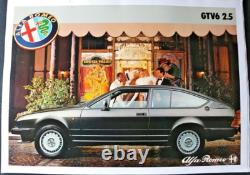
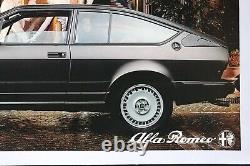
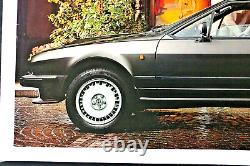
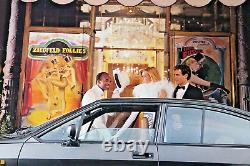
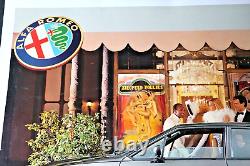
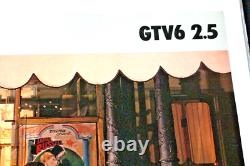


No copies - no reproductions. Approximately 70 x 100 cm.
(+ 3 cm of margin for protection and framing). You can contact us for the preservation of your old posters. Alfa Romeo Alfetta GTV 2.0. 1,600 - 1,800 - 2,000 - 2,500 - 3,000 cm. Rear-wheel drive with De Dion axle. 8 / 10.5 L/100 km. The Alfetta GT, for Gran Turismo (GTV in Veloce version), is a type of sports coupe produced by the Italian manufacturer Alfa Romeo. It was decided to launch studies for the design of a new coupe model that would replace the Alfa Romeo Giulia GT by the mid-1970s. The specifications called for a body that could comfortably accommodate four passengers instead of the traditional 2+2, with a trunk of sufficient volume for traveling, as was the case with the Fiat 124 Coupe. These constraints were primarily aimed at countering the competition from compact sports sedans that offered similar performance and a good level of comfort.By taking over the mechanical layout of the "Giulia GT" from 1968, Alfa Romeo entrusted the development of the new model to the newly established Italdesign company of Giorgetto Giugiaro. Considering that it was already G.
Giugiaro who had largely participated in the creation of the "Giulia GT" while working at the famous Italian coachbuilder Bertone. As often with Alfa Romeo, the Centro Stile Alfa was also tasked with completing a parallel project. 1978 Alfa Romeo Alfetta GTV Series 1. At its presentation in 1974, the base model's engine relied on the all-aluminum engine of the Alfetta sedan.The famous double overhead cam 1,779. Developing 122 hp DIN (140 hp SAE) at. This allowed the car to easily reach a speed of 195 km/h. Two years later, in 1976, this engine was replaced by two new displacements of 1,570. With 122 hp but at.
The manufacturer took the opportunity to make slight adjustments to the finish details, such as the new grille design, the fuel cap not covered by a flap. The brand name now appears in uppercase above the rear license plate.The two versions, 1.6 GT and 2.0 GTV, are distinguished only by the two rubber bumpers on the bumpers, two chrome trims on the grille, and the GTV inscription on the rear air vents of the 2.0 GTV. In 1978, the GTV 2.0 became GTV 2.0 L, whose engine gained an additional 8 hp to reach 130 hp DIN at. The manufacturer made a functional modification by returning to the rubber-sealed windshield with a chrome trim instead of the glued windshield, which could present sealing problems over time. In 1979, Alfa Romeo presented the GTV 2.0 Turbodelta version, which adopted the engine from the 2.0 L version but with a "Alfa Avio" turbocharger, and later "KKK", which raised the power output to 150 hp. This version is recognizable by its bulging black engine hood and the "Turbodelta" inscriptions with the AutoDelta logo on the lower doors.
In 1980, Alfa Romeo launched an updated series of its Alfetta with the disappearance of the 1.6-litre engine and introduced a high-end version equipped with the magnificent 2,492 V6 Busso. Developing 160 hp DIN at. The new version is easily recognizable with its many black inserts. The hood of this 2.5 L version features a bulge to accommodate the larger 6-cylinder engine, and its alloy wheels have 5 bolts. A final version was presented in 1983 with a very slight facelift. The Alfetta GT was a very popular car in Italy as well as abroad, which was fond of customized models requiring mini-series by country with particular equipment and engine configurations.The "America" version was fitted from the start with a 2.0-litre engine with fuel injection to comply with current US regulations. In the UK, it was necessary to create the "GTS 1.6" and "GTV Strada" versions specific to match the Italian series versions but with full options and more British finishes. To satisfy a German demand in 1977, Autodelta, the racing division of Alfa Romeo, had to produce a series of 20 examples of the "GTV 2.6 V8". This version was equipped with the V8 engine from the Alfa Romeo Montréal. Developing 200 hp DIN and could reach 230 km/h with impressive accelerations, 0 to 100 km/h in 7.5 seconds.
Two years later, in 1979, to obtain homologation in "Group 4" of the FIA Rally Championship category A (grand touring cars), Alfa Romeo built 400 cars of the "Turbodelta" version, with a 2.0-litre turbocharged engine. In 1981, Alfa Romeo launched the "Grand Prix" version to celebrate the brand's return to Formula 1.
The entire interior layout was reviewed and treated with maximum elegance and luxury, and the vehicle's order number was displayed on the dashboard. The body and its accessories such as exterior mirrors, spoilers, side skirts, and bumpers were only available in Alfa racing red.
The tires were extra wide low-profile (for the time) 195/60 HR15 mounted on black alloy wheels with silver edges, the famous "Quadrifoglio" green four-leaf clover on the rear air outlets. The only regret for enthusiasts was that the engine was the base 2.0-litre. This special "Grand Prix" version was produced in 650 numbered examples: 250 reserved for the Italian market, 200 for France, and 200 for other European markets. The Carrozzeria Maggiora produced these versions.
In 1984, the Alfa Romeo South Africa subsidiary produced 200 examples of the GTV 3.0 V6 with right-hand drive for the local market. However, a few examples were recently found in other countries with left-hand drive.The first six Alfa Romeo GTV 2.0 L imported to France arrived in the summer of 1976 with the importer of the time, GAP Automobiles. The last examples sold in France were registered in. Tony Ricciardello's Alfa Romeo Alfetta GTV Sedan-Chevrolet in 2014. The Alfetta GT proved to be one of the most appreciated Alfa Romeo cars in this category by Italian customers, but also and especially foreign ones, whose specific requests led to numerous versions and special series with particular finishes and engine configurations. The "America" version was fitted from the start with a 2-litre injection engine to comply with US emission regulations.
In the UK, the marketed models included the "GTS" 1,600 and "GTV Strada" 2,000 versions. Corresponding to the series models but with a full equipment level and very high-end finishes. At the special request of the German network in 1977, Delta Technik produced a version of the "GTV 2.6 V8", a confidential series of 100 planned examples. Equipped with the V8 2.6L engine from the Alfa Romeo Montreal. Developing 200 hp, it could reach 230 km/h.Based on the GT V8 3.0L Racing from Autodelta, a factory racing car made in two examples. Unfortunately, only two cars were produced in Germany before the company went bankrupt.
Two years later, to obtain homologation in Group 4 of the Rally Championship, 400 examples of the "Turboldelta" version were produced, with a two-litre engine powered by a turbocharger. In 1980, a series of GTV 2.0 L was modified by the German supplier Delta (not to be confused with the racing department AutoDelta).
This Delta version has a power output of 140 hp thanks to a Bertone 2000 camshaft, different jets on the carburetors (SOLEX). This model featured a SEBRING exhaust, fender flares, a spoiler, and specific plastic bumpers. It is estimated that between 200 and 1,000 examples were produced. In 1981, the "Grand Prix" version was made to celebrate Alfa Romeo's return to Formula 1. All interior finishes were modified: black velvet with gray stripes, red carpet on the floor, identification plaque with the progressive number of the example on the dashboard, leather-wrapped steering wheel, and the exterior: body color exclusively red with black stripes, front and rear bumpers, front spoiler, side skirts, and mirrors in the same color as the body, tires 195/60-15 mounted on black alloy wheels with silver edges, and green quadrifoglio on the rear air outlets.
The "Special Grand Prix" version will be manufactured in 650 stamped examples, of which 250 are intended for the Italian market, 200 for the French market, and the last 200 examples for all other European countries. The Special layout was done by the Italian coachbuilder Maggiora. In 1984, Alfa Romeo France marketed a limited series of 300 examples "GTV PRODUCTION" with GTV 2.0 and GTV6 2.5 engines. This series celebrates the victory in the French Production Championship of the GTV6s entered by the Snobeck team.
The cars are equipped with a body kit developed specifically by the supplier STAND21, available only in Metallic Gray or Red, the GTV Production is identifiable by its commemorative plaque in the glove compartment, its specific wheels (GOTTI J55C bi-color on the GTV6 and Ronal A1 on the GTV in 7x15 in both cases) and also by their black leather steering wheel. Between 1984 and 1986, Jacques Panciatici achieved nearly ten victories in Gr. N (Production) in the French rally championship and finished third in the 1984 French Championship. In 1985 and 1986, Yves Loubet, vice-champion of France in 1985, and then Dany Snobeck dominated the French Supertourisme Championship. This model enjoys exceptional longevity in tourism, being titled twelve times between 1980 and 2015 in the Australian Sports Sedan Championship, thanks to a Chevrolet engine (Tony Ricciardello winning the last nine titles mentioned).
Finally, between 1984 and 1985, 212 examples of the GTV 3.0 V6 were produced on special order for the South African market by the local subsidiary Alfa Romeo South Africa. The engine of a 1600 GT from 1976. Technical characteristics of Alfa Romeo Alfetta GT 1.8 - 1974. Bore x stroke = 80 x 88.5 mm. With 2 valves, double overhead cam, and double timing chain.
122 hp DIN (140 hp SAE) at 5,500 rpm - 1972 version. 17 mkg DIN (167 N m) at 4,400 rpm. At the rear, at the gearbox entrance, single dry disc, hydraulic control. Rear in the same block as the brakes, with 5-speed + reverse. Rear with a two-section shaft and De Dion axle.
Self-supporting body with differential progressive resistance. Independent, oscillating transverse arms, longitudinal torsion bars, anti-roll bar, telescopic hydraulic dampers. Variable flexibility helical springs, longitudinal thrust arms, transverse Watt's linkage, anti-roll bar, telescopic hydraulic dampers. Disc brakes with dual circuit on all 4 wheels, hydraulic control, brake booster, and limiter on the rear axle, handbrake on the rear wheels.165 SR 14 (optional 185/70 HR 14). 1 km in 31.8 seconds.
At 90 km/h: 6.7 - 120 km/h: 8.9 - city: 12.0 L/100 km. Alfetta GTV Strada (2.0). Alfetta GTV 2.6 V8.
Alfetta GTV L (2.0). Alfetta GTV 2.0 Delta. Alfetta GTV Grand Prix (2.0). Like many other models from the Milanese brand, the Alfetta GTV was assembled by the Alfa Romeo South Africa subsidiary. In South Africa until 1984.A first small series of Alfetta 1800 sedans was assembled in 1973 at the Alfa Romeo factory in Rosslyn, located near Pretoria. However, from 1974 onwards, South African Alfettas were assembled in the new factory that Alfa Romeo built in Brits. South Africa was one of the two markets to have an Alfetta GTV6 Turbo, with a Garrett turbocharger. It is estimated that 750 examples were assembled before production ceased in 1984.
The manufacturer also produced a specific model in South Africa: the GTV6 3.0, well before the official launch of the Alfa Romeo V6 3.0 factory engine in 1987. 212 examples were built in South Africa for racing homologation.
The last 6 examples of the GTV6 3.0 were fitted with electronic fuel injection instead of carburetors. To this day, the GTV6 3.0 remains the epitome of Alfa Romeo for South Africans.
Alfa Romeo South Africa GTV6 3.0 recognizable by its bulging hood. Alfa Romeo GTV6 3.0. The GTV6 3.0 was presented as the most powerful production sports car ever built by Alfa Romeo.
It was the result of cooperation between Alfa Romeo South Africa and the sports and racing division of Alfa Romeo Italy. The car was primarily developed for racing. To achieve this, 200 civil examples had to be built for homologation. The goal of the South African executives was to compete against the BMW 535i, equipped with a 3.5-litre engine.The new 3-litre Alfa Romeo engine proved its superiority by beating it on numerous occasions. The GTV6 achieved its first victory in the two-hour Group 1 International race at Kyalami. Places in the Group 1 class of the Three Hours of Castrol at Killarney and its victory in the classification of the World Endurance Championship of 1000 km at Kyalami in. The Alfa Romeo engine had a displacement of 2,934. And developed 174 hp DIN, with a top speed of 224.2 km/h and an acceleration from 0 to 100 km/h in 8.36 seconds.
8C Competizione and 8C Spider. Alfa Romeo 2300 Ti 4. See Alfa Romeo Industrial Vehicles. Trucks & utilities manufactured under license abroad.

